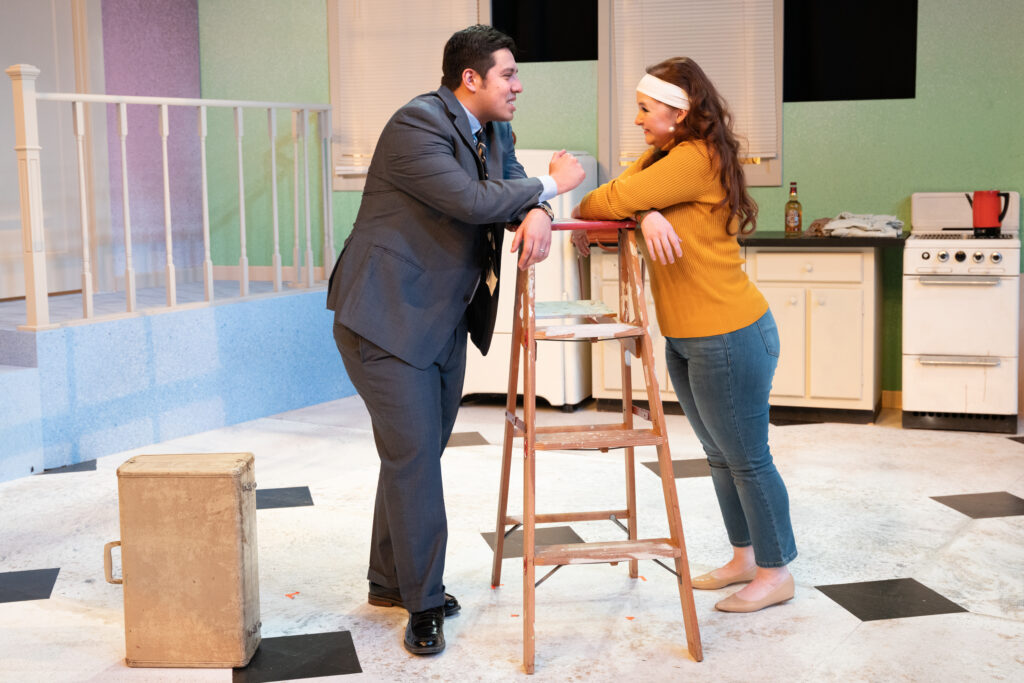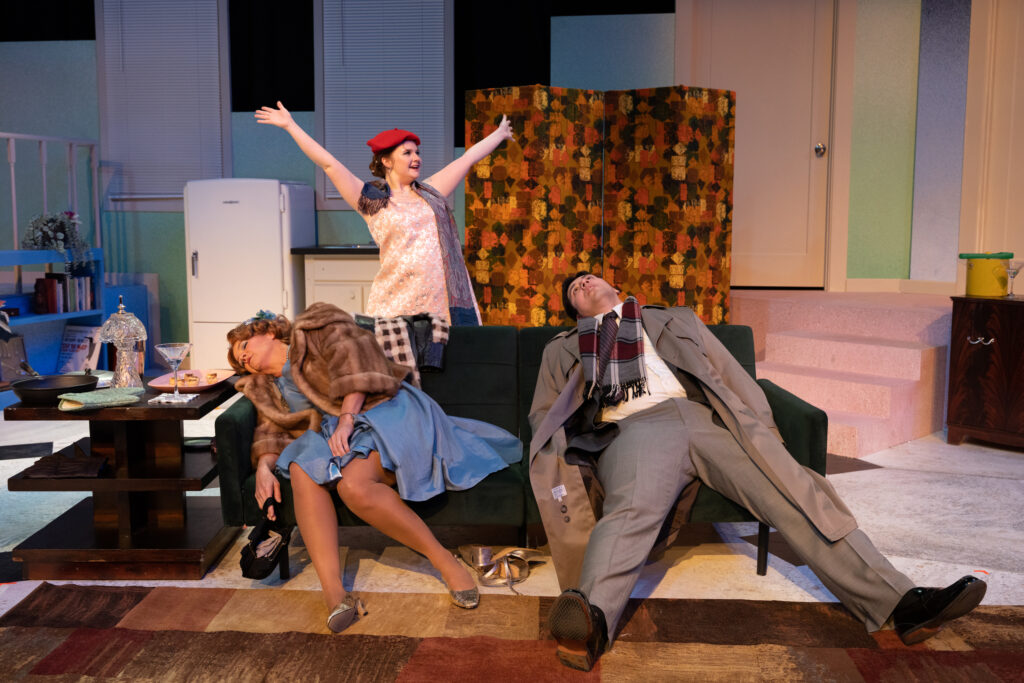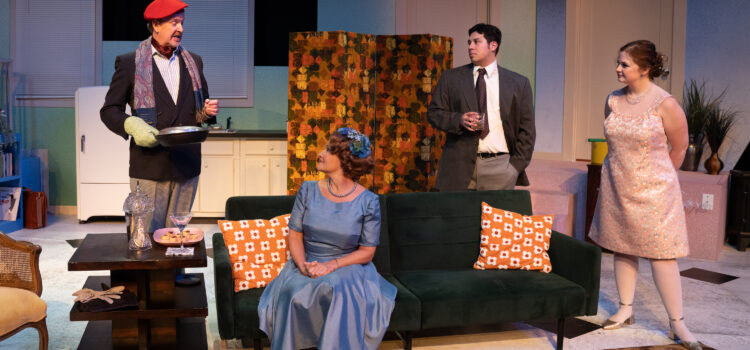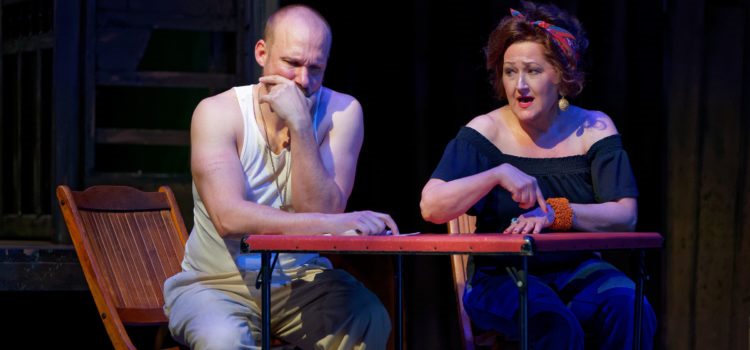By Lynn Venhaus
With its jaunty game-show music and kicky retro fashions, Moonstone Theatre Company’s staging of Neil Simon’s “Barefoot in the Park” is a throwback to amiable, innocuous 1960s-era sitcoms.
Only the Wayback Machine hasn’t been kind to Simon’s first major success in 1963, a fluffy lighthearted comedy about a couple with opposite personalities starting married life. They live in a fifth-floor walk-up apartment in Manhattan’s Greenwich Village, which becomes a running gag.
A smash hit that ran four years on Broadway, the breezy trifle was directed by Mike Nichols, garnered four Tony nominations and he won for directing. In 1967, the popular movie adaptation paired Robert Redford, the original Paul on stage, with Jane Fonda as the ditzy Corie, and the sublime Mildred Natwick recreated her scene-stealing timid mother role. The play went on to be a beloved staple of school, community, and dinner theater. It was a go-to during high school speech meets for duet-acting partners back in my day.
But that was then, and this is now.
Sixty years later, it’s flimsy rather than frothy — a period piece that probably wouldn’t make the cut for a 1960s-time capsule if selections were today, despite Simon’s hit-making machine status.
The antiquated attitudes on wives and mothers are hard to surmount – we’ve come a long way, baby. I suppose looking back at the pre-feminism years reinforces how times have changed. But engaging? Not so much.
The dialogue reflecting the time’s societal mores is sometimes cringy. Corie’s widowed mom advises: “Make him feel important. Give up a little of yourself. If you do that, you’ll have a happy and wonderful marriage — like two out of every 10 couples.”
Moonstone has set the show in 1966. The cast tries hard to toss off one-liners with some pizzazz but are hampered by how dated the wisecracks sound.
However, the cast gets the rhythm of Simon’s trademark patter, and the genial performers supply several bright spots because of their commitment to the characters.
Particularly funny are well-known veteran actors Chuck Brinkley, who plays the jovial telephone repairman – back when rotary dial was standard, and a Princess phone was fancy — and Bob Harvey, doing funny physical schtick as a huffing-and-puffing delivery man. Ever reliable, the old pros’ brief bits are amusing.
Appealing performers Luis Aguilar and Rhiannon Creighton convey the newlyweds and do what they can to enliven the creaky conversations, but the thinly drawn Mr. and Mrs. Bratter roles have never seemed so bland. They move in after a 6-day honeymoon, and all the character tics appear to aggravate.
This depiction, when the man was the breadwinner and the woman was the happy homemaker, is simply stale.
While cheery and sweet at times, bride Corie does come off as clingy, whiny, and shallow in other moments. Intended as an early image of Simon’s adored first wife Joan, Corie is not as interesting as screwball heroines of days gone by because there’s not much character development. She’s advertised as a ‘free spirit’ but seems tamer in retrospect.
Domestic bliss is threatened because she fears her fuddy-duddy lawyer husband, who is trying to concentrate on his job, will never be spontaneous, like she is. For instance, he wouldn’t walk barefoot in Central Park on a frigid winter day.

Faring better, although stuck in the tired stereotype of hovering suburban mom, is Jilanne Klaus as widowed Ethel. She’s in her 50s, an empty nester in New Jersey, and dull as dishwater. But she will soften and lighten up. Oh, the agism jokes! Let’s get the retirement home ready!
Corie’s perturbed that mom keeps sending wedding presents almost daily from Lord and Taylor. Oh, the horror.
The hijinks ramp up when Corie fixes up her uptight mother with the nutty neighbor Victor Velasco for a dinner double date. Starting off with exotic gourmet food and braggadocio, the eccentric Hungarian charms the ladies, but Paul immediately dislikes the international man of mystery.
And the night, fueled by assorted alcoholic beverages and dinner in Staten Island (offstage), gets wild and crazy – especially for the stick-in-the-mud mom and husband. But Corie and Victor are kindred spirits.
Slapstick-y wackiness ensues, and Aguilar deftly displays a flair for physical comedy. TJ Lancaster wisely decides not to go too over-the-top playing the live-wire lothario who lives in the attic. He and Klaus demonstrate they are smart, instinctual performers whose crisp comic timing and ease on stage is a plus.
Those two gave a master class in recalibrating their moves when the pair, mindful of a hump in the set’s area rug, acted nonplussed and went on with the show, careful where they stepped during Friday night’s third act.
When the inevitable blow-up occurs in act two – because Paul is a “watcher” and Corie is a “doer,” the couple’s bickering becomes tedious while we’re waiting for the happy-ever-after resolution. No suspense there. Although the fact they didn’t realize their differences before wouldn’t seem to bode well for the future (nevertheless, the Simons were married for 20 years until Joan’s death from cancer at age 41).
One of the most commercially successful playwrights of all-time, Simon, who started writing comedy sketches in the pioneering days of early television, made a career out of first world problems – only the world never really intruded into his work until the brilliant Eugene trilogy, starting with “Brighton Beach Memoirs.”
His customary white middle-class struggles were usually connected to relationship clashes, poking fun at human foibles and using self-deprecating humor, which frequently included Jewish characters in urban settings.
So, the pleasant bon mots and jokes on the squalor of a tiny big-city apartment are expected.
Only, the set isn’t so small. While acclaimed scenic designer Dunsi Dai’s work is a perfect palette of pastels reflecting the time, and his skylight is certainly a “Wow,” it’s too spacious for a supposedly cramped one-bedroom apartment. (If you have been in modest New York City apartments, you know, unless you assume they’re all like “Friends.”)
And the setting is not practical for stage movement, for Creighton must scamper quite a bit – it’s a good thing she’s energetic because we watch her take a lot of steps as she crisscrosses for unpacking, decorating and scene requirements. In a modern setting, she’d be killing it on Fitbit. Director Sharon Hunter’s blocking seems clunky because of the larger dimensions.
Patrick Sullivan’s striking lighting design capably illuminates the night sky, and Amanda Werre’s sound design is smooth.
Michele Siler’s costume designs are noteworthy, having ideally captured the period’s everyday apparel for the women, and Emily Fluchel nails the props – the suitcases, kitchen wares and knickknacks.
Despite it being Simon’s longest-running hit, this would be difficult to pull off in any 21st century theater because it feels synthetic. Nevertheless, the performers’ chemistry and nimble line delivery elicit laughs.
Like so many other plays that depend on a mundane premise to begin with, “Barefoot in the Park” is an unusual classic to present because of the shift in male-female dynamics. No amount of rejuvenation can resuscitate it, despite this likable ensemble and their earnest efforts.
Moonstone Theatre Company presents Neil Simon’s comedy “Barefoot in the Park” from Oct. 27 through Nov. 13 at the Kirkwood Performing Arts Center’s black box theatre, 210 E. Monroe Ave. Showtimes are Thursdays through Saturdays at 7:30 p.m. and Sundays at 2 p.m., except there is no show on Friday, Nov. 11, and two shows on Saturday, Nov. 12, at 3 p.m. and 7:30 p.m. For tickets or for more information, visit: www.moonstonetheatrecompany.com.


Lynn (Zipfel) Venhaus has had a continuous byline in St. Louis metro region publications since 1978. She writes features and news for Belleville News-Democrat and contributes to St. Louis magazine and other publications.
She is a Rotten Tomatoes-approved film critic, currently reviews films for Webster-Kirkwood Times and KTRS Radio, covers entertainment for PopLifeSTL.com and co-hosts podcast PopLifeSTL.com…Presents.
She is a member of Critics Choice Association, where she serves on the women’s and marketing committees; Alliance of Women Film Journalists; and on the board of the St. Louis Film Critics Association. She is a founding and board member of the St. Louis Theater Circle.
She is retired from teaching journalism/media as an adjunct college instructor.




